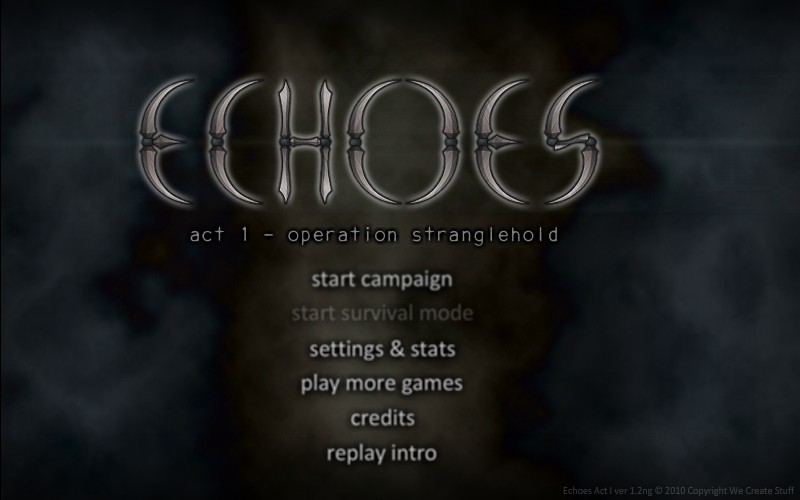
The amendments gives the same protection to roadside maintenance workers and snowplow operators that first responders and tow truck operators already had. Then the issue gets compounded and things get extremely dangerous for everyone,” Savinkoff said.
Echoes act 1 Patch#
“Perhaps it’s a patch of black ice that caused an accident and now you have other people coming up to your vehicle stop and they’re going to experience the same black ice that got the first person into trouble. It could be to issue a traffic ticket, or it could be a more dynamic situation like an arrest or assisting someone in distress. He said people also don’t know why a police vehicle has stopped. Everybody needs to take appropriate care when passing emergency vehicles,” Savinkoff said.

“Vehicles going by at highway speeds do present a real, clear danger for us. Troy Savinkoff, who has felt his parked police vehicle shake from traffic whizzing by at highway speeds, said police and their emergency partners working on the roadside have dangerous jobs. Motorists traveling in either direction on single-lane roads will now also be required to slow down to 60 km/h, or the posted speed limit (whichever is lower), when passing workers with flashing lights.
Echoes act 1 drivers#
To contact the reporter on this story: Kerry Burgott from San Diego at contact the editors responsible for this story: Amanda H.Starting March 1 motorists will face stricter speed restrictions to better protect roadside workers in Alberta.Īmendments to the Traffic Safety Act passed last spring means that all motorists traveling in the same direction on multi-lane roads will have to slow down to 60 km/h, or the posted speed limit (whichever is lower), when passing any emergency vehicle, tow truck, road crew and snowplow operators with flashing lights.Ĭurrently, the law only requires drivers in the lane adjacent to the roadside to slow to 60 km/h. The Navy, and DOD broadly, she said, will need to “shift the education for our operators and acquisition professionals in order to think in a data-centered way.” Susan BryerJoyner, who leads the DOD team implementing the initiative, explained that JADC2 is focused on data, and that shifting to such a data-centered service will take an organizational culture change. The overall Pentagon effort to share information across branches is called Joint All-Domain Command and Control, which was another recurring topic during the conference. Similarly, Tamara “Tami” North, director of Information Warfare Readiness at the Naval Information Forces, in a separate discussion noted information warfare cuts across all areas and acknowledged the “challenge” of training sailors and marines to keep up with rapidly evolving technology. Hines also summarized the importance of the flow of data in the military: “No comms, no bombs.” The Navy needs to have personnel capable of communicating and protecting information, she said.Įarlier: Navy IT Strategy Head on Cybersecurity: ‘We’re Doing It Wrong’ “We’re going to reshape, retool the workforce,” Hines said.

14 remarks and noted the changes that will come with cyber training. Tracy Hines, director of the Navy Cyber Security Division, highlighted the Navy’s Cyber Ready initiative in her Feb. “I do think we are not at our best in training we’re providing for our information warriors,” Aeschbach said. Kelly Aeschbach, Commander of Naval Information Forces, during one session.

There is stress on the Navy’s cybersecurity and cyber warfare abilities because “we were already high demand, low density in many of our skill sets, and we remain that way,” said Vice Adm. Presentations at the conference covered descriptions of workforce development goals and examples of how Department of the Navy leaders expect military personnel, civilian employees, and contractors to reach the skill levels necessary to defend against malicious cyber activity. Secretary of the Navy Carlos Del Toro’s keynote on Thursday referenced the strategy as the retention and training tool that will “help bring the highest return on investment for the American taxpayer.”

The directive for the Cyberspace Workforce Qualification and Management Program is designed to give DOD activities “a broad set of options to manage and achieve a qualified cyber workforce,” according to the Pentagon press release Wednesday.
Echoes act 1 update#
The Defense Department issued its most recent update to its Cyber Workforce Framework midway through the WEST 2023 conference co-hosted by AFCEA International and the US Naval Institute in San Diego. Several Navy officials at a military technology conference this week emphasized to private sector and Pentagon partners that they are prioritizing information warfare training, just in time for the release of a new framework for cybersecurity.


 0 kommentar(er)
0 kommentar(er)
